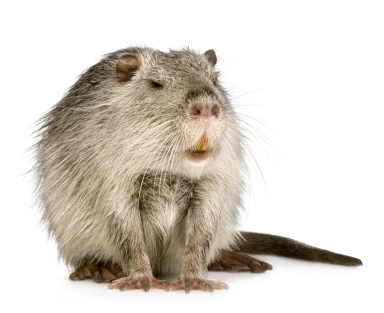Nutria | With the collapse of the fur market in the 1940s, nutria became overabundant and affected thousands of acres of coastal wetland as they grazed on important marsh vegetation. Right, nutria hind foot, showing the webbing between the inner four toes and outer, fifth toe free from webbing. Left, nutria front foot, showing the four toes visible in tracks and the barely visible fifth, residual toe on the inner, lower area of the foot. The body measures up to 70 A round, nearly hairless tail;
In fact, their scientific name myocastor coypus is derived from the greek words for mouse and beaver (mys and kastor respectively). The nutria has a robust body, short limbs, small eyes and ears, long whiskers, and a cylindrical, scaly tail. Beneath this layer is the secondary guard hairs, which are more numerous and give the species its overall coloration. They may also threaten human health and safety and. In fact, they are one of the largest known living rodents in the world that can grow as big as 28 to 42 inches in length.

With the collapse of the fur market in the 1940s, nutria became overabundant and affected thousands of acres of coastal wetland as they grazed on important marsh vegetation. The species has a hunched body; A valvular mouth and nose; Right, nutria hind foot, showing the webbing between the inner four toes and outer, fifth toe free from webbing. The underfur is short, and less dense than either a muskrat or beaver underfur. A round, nearly hairless tail; The toes of the hind feet, except for the hallux, are included in a web. Nutria, (myocastor coypus), a large amphibious south american rodent with webbed hind feet. Beneath this layer is the secondary guard hairs, which are more numerous and give the species its overall coloration. When the nutria fur market collapsed in the 1940s, thousands of nutria escaped or were released into the wild by ranchers who could no longer afford to feed and house them. Nutria cause extensive damage to wetlands, agricultural crops, and structural foundations such as dikes and roads. The whiskers on a nutria are obvious. Left, nutria front foot, showing the four toes visible in tracks and the barely visible fifth, residual toe on the inner, lower area of the foot.
The nutria is unique in that it has 3 sets or lengths of fur. It can weigh up to 17 kg (37.5 pounds), although 5 to 10 kg is usual; The nutria has a robust body, short limbs, small eyes and ears, long whiskers, and a cylindrical, scaly tail. A valvular mouth and nose; As an adaption to the aquatic environment, the eyes, nostrils, and small ears are set high on.

As an adaption to the aquatic environment, the eyes, nostrils, and small ears are set high on. In fact, they are one of the largest known living rodents in the world that can grow as big as 28 to 42 inches in length. Left, nutria front foot, showing the four toes visible in tracks and the barely visible fifth, residual toe on the inner, lower area of the foot. Beneath this layer is the secondary guard hairs, which are more numerous and give the species its overall coloration. The toes of the hind feet, except for the hallux, are included in a web. They may also threaten human health and safety and. Nutria rats (also called coypu, river rats, and giant swamp rats) are incredibly large rodents that are native to south america. The whiskers on a nutria are obvious. When the nutria fur market collapsed in the 1940s, thousands of nutria escaped or were released into the wild by ranchers who could no longer afford to feed and house them. Nutria can be found anywhere in or near freshwater or estuaries. A valvular mouth and nose; With the collapse of the fur market in the 1940s, nutria became overabundant and affected thousands of acres of coastal wetland as they grazed on important marsh vegetation. The species has a hunched body;
In fact, they are one of the largest known living rodents in the world that can grow as big as 28 to 42 inches in length. With the collapse of the fur market in the 1940s, nutria became overabundant and affected thousands of acres of coastal wetland as they grazed on important marsh vegetation. A round, nearly hairless tail; They may also threaten human health and safety and. Nutria rats (also called coypu, river rats, and giant swamp rats) are incredibly large rodents that are native to south america.
The nutria has a robust body, short limbs, small eyes and ears, long whiskers, and a cylindrical, scaly tail. With the collapse of the fur market in the 1940s, nutria became overabundant and affected thousands of acres of coastal wetland as they grazed on important marsh vegetation. The underfur is short, and less dense than either a muskrat or beaver underfur. They may also threaten human health and safety and. Nutria cause extensive damage to wetlands, agricultural crops, and structural foundations such as dikes and roads. Nutria can be found anywhere in or near freshwater or estuaries. It can weigh up to 17 kg (37.5 pounds), although 5 to 10 kg is usual; Primary guard hairs are about 3 inches in length. In fact, their scientific name myocastor coypus is derived from the greek words for mouse and beaver (mys and kastor respectively). The body measures up to 70 When the nutria fur market collapsed in the 1940s, thousands of nutria escaped or were released into the wild by ranchers who could no longer afford to feed and house them. Right, nutria hind foot, showing the webbing between the inner four toes and outer, fifth toe free from webbing. Nutria rats (also called coypu, river rats, and giant swamp rats) are incredibly large rodents that are native to south america.
Nutria: The body measures up to 70
0 comments:
Post a Comment